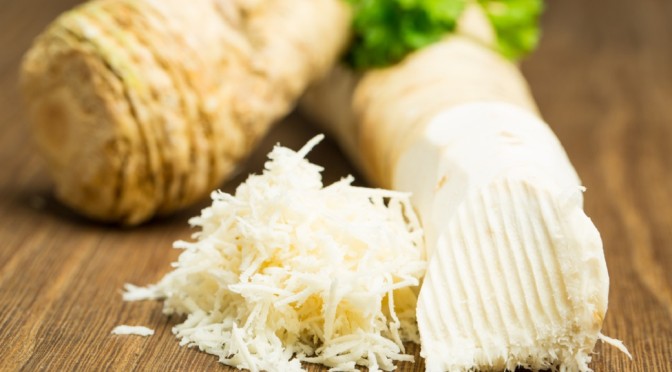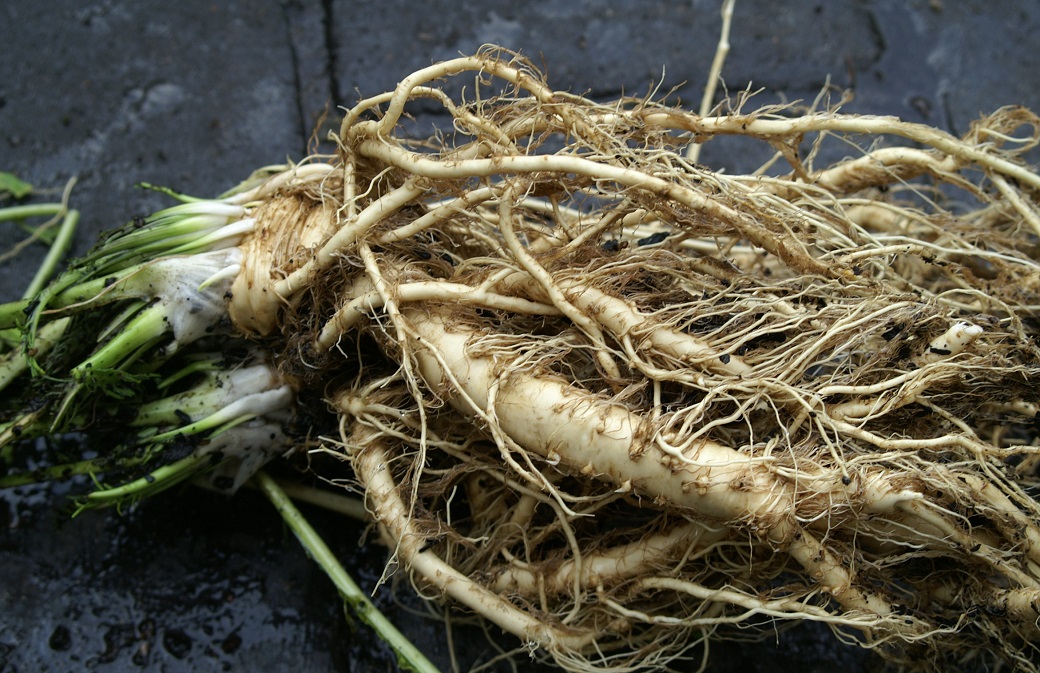From Mrs. Cog's Corner
The content on this page is for discussion purposes relating to health and well being only and is not intended to be medical advice. Links and sources provided are for informational purposes and do not represent an endorsement of a person, product or treatment.
Right up there with dark chocolate, flavored coffee and tomato soup, one of the food items I wouldn’t want to do without is horseradish. Until recently I thought it came from the grocery store in a small overpriced jar. But it turns out horseradish is a hardy perennial and very healthy to boot.
Cog was downright alarmed when I explained just how invasive horseradish is. It seems once a taproot grows during its first year, it is nearly impossible to get rid of it. Ever! Any small bit, even a flake of the root left in the ground will come back as a full plant the following year. One blogger wrote of removing the large root with a cable and a truck only to have the plant reappear the following year.
It is for this very reason most gardeners recommend NOT planting it in the garden. Thank goodness it grows prolific and hardy in large containers. Cog has asked me if the wind could carry a speck of the root and replant itself in the yard. I’m gambling that I can control it in a very large pot on the deck and have planted my first root.
Horseradish grows in climate zones 2 through 9 and can thrive in as little as four hours per day of sun, but prefers plenty of sunshine. Growing about three feet high and spreading its big leaves as wide, this plant wants plenty of elbow room and will easily crowd out smaller neighbors.
Like its cousin wasabi, horseradish is considered a superfood. Containing ten times the anti-cancer glucosinolate found in broccoli, a little bit of the real thing goes a long way. Studies have shown horseradish enables the body to detoxify from toxins that trigger the growth of cancer.
Horseradish has long been used for sinus infections because it contains both powerful antibiotic properties as well as the ability to clear stuffy sinuses very quickly. It is recommended to treat various digestive disorders, urinary tract infections and as a remedy for kidney stones.
Simple enough to prepare, instructions on how to grate and store it can be found here on Simply Recipes or here on The Global Gourmet.
There are many ways to use it. Some of my favorites include mixing it with sour cream to eat with potato skins or baked potatoes or straight up on the side of roast beef. The most peculiar method is a weird family tradition of eating it atop peanut butter on a Ritz cracker, especially on the side of a bowl of tomato soup.
We’d love to hear how you all eat your horseradish!
Video below from DoomandBloom.net
For more reading:
An excellent pdf eBook including how to grow, harvest and prepare which includes recipes: https://herbsociety.org/horseradish/documents/01-24-11Horseradish_Guide_single_without_buttons.pdf
“The Oracle at Delphi told Apollo that the radish was worth its weight in lead, the beet its weight in silver, and the horseradish its weight in gold,” Arthur O. Tucker and Thomas DeBaggio wrote in “The Big Book of Herbs” (Interweave Press, 2000). http://www.nytimes.com/2010/04/01/garden/01horseradish.html
To prepare Horseradish, first start with a well ventilated room because the fumes are potent - a whiff may be stronger than you expect! It is also recommended that you wear gloves when working with fresh horseradish because the roots contain highly volatile oils which are activated when crushed. https://www.netherlandbulb.com/index.cfm?fuseaction=wholesaleplants.plantDetail&plant_id=7173
As a medicine horseradish root has many curative properties: strong antibiotic, expectorant, bronchodilatator, antibacterial, coronary vasodilatator, it increases the blood pressure, it heats up the body, stimulates the body's immune system, anti-inflammatory, antiparasitic, antianemic, antiscorbutic, diuretic. It can stimulate the appetite. It has a cardiotonic effect and is recommended to the people who suffer from high blood pressure. Also it is known that horseradish has aphrodisiacal properties. http://www.liveandfeel.com/articles/benefits-of-horseradish-plant-1715
http://www.gardeningblog.net/how-to-grow/horseradish/
http://suburbantomato.com/2012/06/growing-horseradish-in-a-pot/
http://www.harvesttotable.com/2009/01/how_to_grow_horseradish/


Much thanks for the inspiration – of late I’ve picked up bottles of prepared horseradish in the stores, looked at the ingredients, and said, “Naw.”